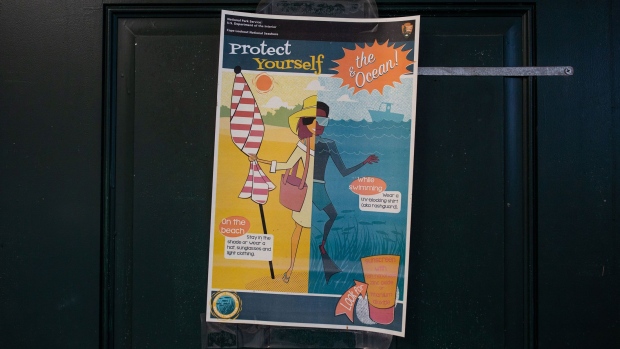Aug 3, 2023
Could Your Sunscreen Be Contributing to Beach Erosion?
, Bloomberg News

(Bloomberg) -- “It’s raining,” Conrad Downs, 9, told his dad, not exactly happy to have been dropped off by a ferry on an empty island under a gray July sky with a constant downpour.
“That’s science, rain or shine, Con,” his dad, Craig Downs shot back, striding down the beach in a clear sign Conrad should settle in for a wet morning.
The pair were dressed for sun and 80F-plus degree heat — the norm this at time of year on Shackleford Banks along North Carolina’s coast, which is usually teeming with tourists. But they eschewed sunscreen in favor of sun hats with neck and face flaps, pants and long-sleeved shirts.
Downs, 52, led the seminal research published in 2015 linking chemical sunscreens to coral harm. Now he’s investigating whether the products may lead to beach erosion. Conrad was on the island to count ghost crabs with the help of his godmother, Cheryl Woodley, a marine ecologist. Downs, who runs a nonprofit research organization in central Virginia called Haereticus Environmental Laboratory, was assessing the health of dune plants. Both projects may be the start of what he envisions as a second campaign further linking chemical sunscreens to environmental harm.
Chemical sunscreens have active ingredients that penetrate skin and absorb ultraviolet rays, as opposed to mineral versions that sit on skin and block the rays. Those chemical ingredients can stress corals, cause them to lose their vibrant colors and leave them more susceptible to disease and death, according to Downs’ research. Entire tourism industries depend on colorful coral — and so do large ecosystems of marine life that use the reefs for shelter and protection.
The leading cause of coral bleaching is climate change, according to the National Oceanic and Atmospheric Association. Several authoritative bodies, though, have raised concerns about chemical sunscreens. NOAA acknowledges that sunscreen chemicals threaten coral, and in 2019, the US Food and Drug Administration raised safety concerns about 12 chemical sunscreen ingredients. Last year, the National Academy of Sciences said more research needed to be done to fully understand sunscreen’s impact on aquatic life, but Hawaii’s state legislature isn’t waiting. In 2021, a law took effect there banning sales of two kinds of chemical sunscreens. The US Virgin Islands has also banned three kinds of chemical sunscreens.
The lobby group for sunscreen products, the Personal Care Products Council, discounts the connection between sunscreen chemicals and coral reef bleaching. “There is no convincing scientific evidence that, under naturally-occurring conditions, sunscreen ingredients are contributing to this issue,” the group said. It had told the FDA it would provide human safety data on chemical sunscreen ingredients by this year but it still hasn’t done so.
“Reef-safe sunscreen” is everywhere now, and people are increasingly choosing to buy mineral sunscreens. When it issued its warning about chemical sunscreens in 2019, the FDA also said that the active ingredients used in mineral sunscreen — zinc oxide and titanium dioxide — were safe. Those ingredients aren’t known to harm coral reefs, particularly in non-nano versions, meaning the particle sizes are larger, making them less likely to penetrate reefs.
Downs’ 2015 research showed sunscreen in the water is an endocrine disruptor for the coral, meaning it can cause its hormones to function improperly. His latest work aims to determine if sunscreen is toxic to plants that help stabilize dunes, and by extension, the shoreline. Plants may be exposed to the chemicals by beachgoers using spray sunscreen as well as any sunscreen-laced ocean spray.
“The dune matters because it protects us,” Downs said after the first day of research. “They protect our real estate value, they protect our fields, they protect our tourism industry, everything.”
Downs spent the second and final day of his research at the Cape Lookout National Seashore. The sun was out in full force as he attached white clips to plant leaves that he hooked up to a handheld machine called a fluorometer which would then log some 200 data points on the plants’ health. Conrad’s count of ghost crabs would be helpful because the creatures are considered a bellwether for the health of a beach ecosystem, including dune plants, where they like to go for shelter and food.
The idea was to visit two sites each at Shackleford Banks and Cape Lookout, one where very few tourists ventured and another that would normally be packed with beachgoers wearing sunscreen. Downs also carefully placed a few sand and plant samples in evidence bags for contamination analysis. He expects to publish a research paper detailing whether sunscreen might harm dune plants as soon as early next year.
“His work is very influential,” said Melissa Lenczewski, a professor at Northern Illinois University’s Department of Earth, Atmosphere and Environment. “I give some of his papers to students to read.”
Lenczewski, who served as a Fulbright Scholar in the last year studying the effect of urbanization on groundwater in Southeast Asia, said Downs’ work on coral reef impacted her recent research measuring sunscreen levels in fresh water in Mexico.
In addition to his part in Hawaii’s ban on chemical sunscreens that contain the active ingredients oxybenzone or octinoxate, Downs published research in 2021 showing sunscreens made with the active ingredient octocrylene contained benzophenone, a suspected carcinogen that also can interfere with key hormones and reproductive organs. Downs’ study suggested that benzophenone was formed by the degradation of octocrylene.
This time around, focusing on plants will allow him to also target active sunscreen ingredients known as “salates,” such as homosalate and octisalate. Salates are derived from salicylic acid. Salicylic acid is a natural plant hormone. It can improve fruit quality in certain amounts when sprayed on flowering plants, but too much can render the blossoms infertile.
“I like to fight,” Downs said about taking on the sunscreen industry again and again. “I actually enjoy the struggle.”
©2023 Bloomberg L.P.


